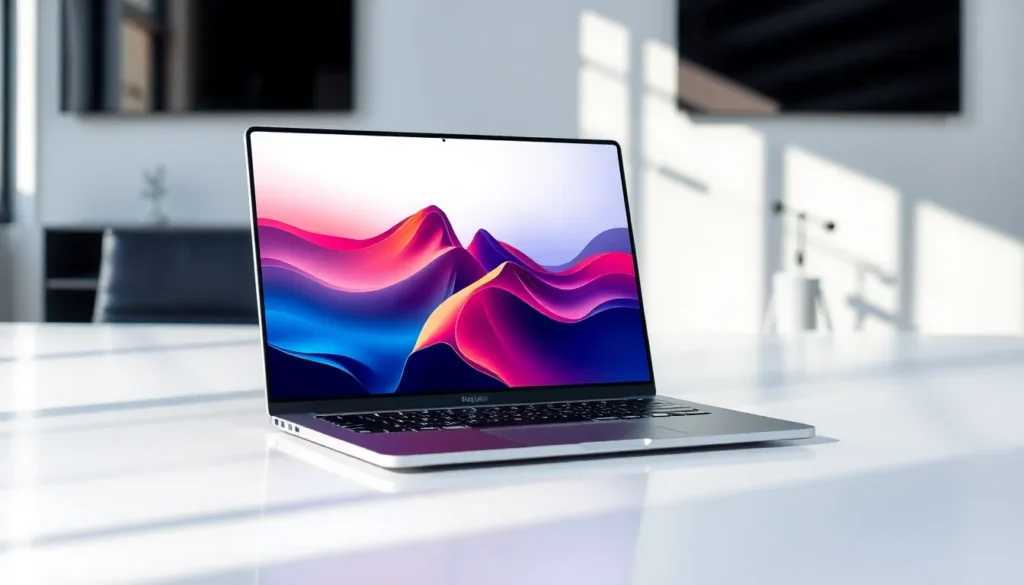Table of Contents
ToggleIn a world where laptops have become our trusty sidekicks, design innovations are shaking things up like a double shot of espresso. Gone are the days of clunky machines that weigh more than a small child. Today’s laptops are sleek, stylish, and packed with features that make even the most tech-savvy among us do a happy dance.
From ultra-thin profiles to flexible hinges that bend over backwards—literally—these innovations are not just eye candy; they’re game-changers. Imagine a laptop that knows how to adjust its brightness based on your mood or one that can transform into a tablet with a flick of the wrist. The future of laptop design is here, and it’s more exciting than a cat video on a Monday morning. Buckle up as we dive into the latest trends that are redefining how we work, play, and binge-watch our favorite shows.
Overview of Laptop Design Innovations
Innovations in laptop design reflect a significant shift in user expectations and technological advancements. Manufacturers focus on creating lighter and thinner devices, with some models achieving weights as low as 1.5 pounds. The introduction of materials like carbon fiber and aluminum has contributed to increased durability without adding bulk.
Display technology has advanced, with many laptops boasting high-resolution screens such as 4K and OLED options. These enhancements not only improve visual clarity but also enhance color accuracy, appealing to creative professionals and casual users alike.
Flexible hinges provide adaptability, allowing users to switch between laptop and tablet modes seamlessly. This feature caters to a growing demand for multi-functional devices, particularly among students and business professionals who value versatility.
Battery life continues to improve, with some laptops now offering up to 20 hours on a single charge. These advancements reduce the need for frequent charging, benefiting users who work on the go. Fast-charging capabilities also ensure that devices can recharge quickly, making them more convenient for busy lifestyles.
Touchscreens are becoming standard in many models, further blurring the line between laptops and tablets. This functionality enhances interactivity, making tasks like note-taking more intuitive for users.
Smart features, such as AI-driven performance enhancements, optimize resource usage based on user habits. Laptops can now adjust settings automatically, promoting efficiency and a personalized experience.
Lastly, eco-friendly initiatives in design reflect a growing concern for sustainability. Manufacturers are incorporating recycled materials and energy-efficient components, appealing to environmentally conscious consumers. These innovations demonstrate a commitment to both user experience and ecological responsibility, shaping the future of laptop design.
Key Trends in Laptop Design

Innovative trends shape modern laptop designs, focusing on enhancing user experience and functionality. Key trends include a shift towards slimmer and lighter models and the rise of flexible and convertible designs.
Thinner and Lighter Models
Manufacturers prioritize portability, producing laptops that weigh as little as 1.5 pounds. Advanced materials, such as carbon fiber and aluminum, reduce weight while maintaining durability. Users benefit from these lightweight options, enjoying greater mobility without sacrificing performance. The emphasis on slim profiles results in devices that are often less than 0.6 inches thick, making them incredibly easy to carry. High-performance components now fit seamlessly into these sleek designs, pushing the boundaries of what users expect from portable technology.
Flexible and Convertible Designs
Flexibility is a defining characteristic of contemporary laptop designs. Devices with innovative hinges allow users to move seamlessly between laptop, tablet, and tent modes. This versatility appeals to students and professionals requiring adaptability for various tasks. Such designs often incorporate touchscreen functionality, enhancing interactivity for applications like note-taking or presentations. Notably, models that convert into tablets cater to the growing demand for multi-functional devices, ensuring that users can adjust their setups based on their specific needs.
Advances in Display Technology
Laptop displays have undergone remarkable advancements, enhancing viewing experiences significantly. High-resolution screens, including 4K and OLED technologies, deliver stunning visual clarity and vibrant colors. Users benefit from improved color accuracy, making these displays ideal for creative professionals working on design projects. Furthermore, these high-resolution options cater to casual users wishing to enjoy movies or play video games with incredible detail.
Touchscreen features have also revolutionized student and business professional interactions with laptops. These screens allow for effortless navigation and intuitive use, making functions like note-taking and presentations more engaging. Laptops with touch capabilities support various gestures like pinch-to-zoom and swipe, enhancing user convenience. In addition, hybrid devices often incorporate both touch and traditional input methods, providing versatility to meet different user preferences. Overall, the integration of these innovative display technologies elevates the entire laptop experience.
Enhanced Performance and Functionality
Modern laptops boast significant performance and functionality improvements, aligning with user demands and technological advancements.
Improved Battery Life
Long-lasting battery life stands out as a major innovation, with some models delivering up to 20 hours on a single charge. Fast-charging capabilities further enhance convenience, allowing users to power up quickly during busy days. Many laptops now integrate smart battery management systems that adapt to usage patterns, optimizing power consumption effectively. Certain devices even feature energy-efficient components, which contribute to extended battery longevity. Users experience less downtime, enabling seamless work and entertainment throughout the day.
Innovative Cooling Solutions
Innovative cooling solutions are crucial for maintaining performance in sleek laptop designs. Advanced thermal management technologies, like vapor chambers and heat pipes, distribute heat efficiently across components. Manufacturers design these systems to minimize noise, enhancing user comfort during operation. Some devices utilize liquid metal thermal paste, improving heat transfer and allowing for higher performance without overheating. Features such as adjustable fan speeds and temperature monitoring enhance the overall user experience, preventing thermal throttling while maximizing potential.
Sustainability in Laptop Design
Sustainability plays a vital role in modern laptop design. Manufacturers increasingly prioritize eco-friendly practices to align with consumer values.
Eco-Friendly Materials
Companies incorporate recyclable materials into chassis and components. Aluminum, for example, remains a popular choice due to its durability and recyclability. Biodegradable plastics also gain traction in manufacturing, minimizing environmental impact. Some brands utilize ocean-bound plastics, transforming waste into valuable resources. Innovations in material science lead to new composites that reduce reliance on virgin materials. Many manufacturers also partner with organizations that focus on sustainable practices, enhancing brand credibility and responsibility.
Energy Efficiency Initiatives
Initiatives aimed at energy efficiency are fundamental in laptop design. Devices boast low power consumption rates while maintaining high performance. Energy Star certifications provide consumers with a guideline for energy-efficient products. Adaptive brightness technologies ensure screens only use necessary power based on ambient light. Fast-charging features reduce overall energy consumption during use. Selecting energy-efficient components contributes to longer battery life, promoting eco-friendly usage patterns. These initiatives collectively reflect a concerted effort to minimize environmental footprints across all stages of a laptop’s lifecycle.
The landscape of laptop design is evolving rapidly with innovations that prioritize user experience and sustainability. As manufacturers continue to push the boundaries of technology, consumers can expect even more versatile and efficient devices. The shift towards lighter materials and advanced display technologies enhances both portability and visual appeal.
Additionally, the commitment to eco-friendly practices reflects a growing awareness of environmental responsibilities. With features that cater to diverse user needs and preferences, the future of laptops promises to be not only functional but also environmentally conscious. These advancements signal an exciting era for laptop technology where style and performance go hand in hand.







